How would I go about weathering a passenger car? There is all sorts of info available on weathering locos, and freight cars, but not much on weathering passenger cars. Granted most railroads probably took better care of cleaning passenger cars, but still, they had to get dirty sometime.
I would think they would weather like a freight car, only less so. Road grime on the trucks and lower edges, soot and dust on the roof. Many were stainless, so those wouldn’t rust, but may show some dark streaks. The others would rust in places, or if its a wood car, the paint would fade or chip. Try googling and see if you can come up with a real world example of what you are looking for.
Wash them with dirty water!
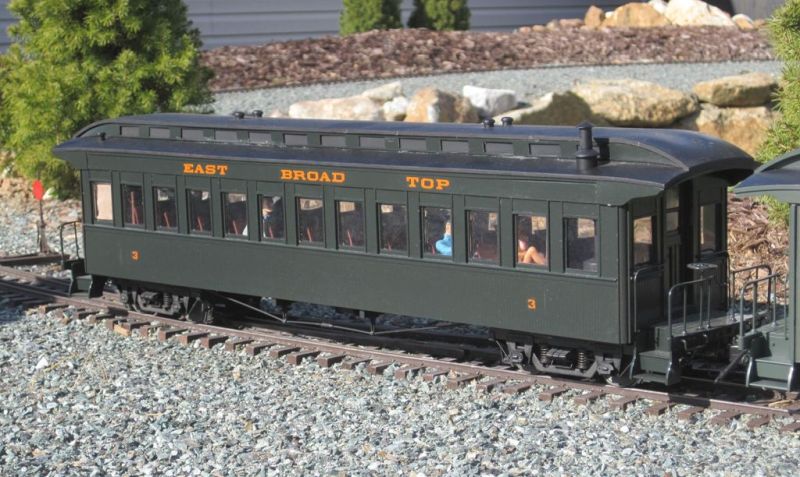
My technique is to use black flat acrylic paint much diluted (50% or worse) and wash it over the coach. It takes off the shine and looks just like dirty rainwater!
That is a fine looking coach Pete. is it custom?
I’d say less is more Daniel when it comes to weathering a passenger car because they were kept up better than freight cars.
I’d remove the trucks and wheels and give them a dusting of rust using primer and add a bit of flat grey and black to it. The car bodies can have a bit of rust added to them say at the end beams and stove pipe. Using a dry brush where you dip the brush into paint and then wipe it on a paper towel and then lightly apply what is left to the car.
You could also dust the car body around the truck area with a fine spray of grey. Practice this technique on a piece of cardboard first.
Taking the shine off the cars is an excellent suggestion. You could spray the car with a clear coat of matte, satin or flat but you would need to either cover or remove the windows. Any custom painting I do gets a coating of clear to help protect it.
Daniel
I agree with your comment on the passenger cars getting better care than other rolling stock. They also used better quality paints with smoother finishes that helped shed the filth.
I have seen the comment “less is more” repeated many times in the small scale magazines regarding weathering passenger trains and have taken that to heart. I let the freight cars take the abuse and model my coaches as the pride of the fleet.
Caution on the following: Let each coat dry or they melt into each other and you get shine instead of dull. Warm day or what should be a clear coat will glop up and look like heavy frost or snow.
To get the kind of light weathering I want I start with several coats of DullCote (actually a less expensive equivalent called Treehouse Matte which you can get at Hobby Lobby) sprayed on a warm still day. Let each coat dry for at least thirty minutes. Make sure you remove or tape over windows. Normally we stop after one or two coats of this stuff but you will need to do 5 or more as this will knock down the shine and create a sun bleached fading /silvering look. Example: you live in the Southwest like me so basically every car over ten years old that is never in a garage.
At some point you have to put color on. An airbrush is best and that is what I recommend but in large scale you can getaway with plain old spray paint.
I cannot over emphasize this enough. > Do the following on a warm still day (I like 80+). I change cans after two cars, use the rest on regular painting projects. Do not for any reason try to use regular gray primer. It is way to thick for this process.
Once the matte is dry I take a brand new can of light flat gray paint, the $1 cheapy stuff from Walmart, and with the car placed on a narrow riser I spray one misty coat along the bottom only. The nozzle pretty much even with the trucks. A brand new can, well shook, will produce the highest pressure aerosolizing the paint into a fine mist. From 2 feet away the paint will billow up and create a very good equivalent to road grime. The paint will go on in a fading coat lighter at the top and heavier at the bottom. Perfect since road grime comes up from the ground (rain and soot come from above which is why washes should be from the top down). One pass, two passes…maybe more. Just keep it even on both sides and the ends until you get what you want. And again; less is more. It has been my experience that it is best to stop while you think it is to light. On rolling stock I do a first pass with light tan if you want more weathering you might want to start with that. Finish with 1 more coat of matte as the paint will be dry and not as well adhered as if you were doing a regular paint job. The matte will seal it in.
Practice on a piece of 2X4 as technique is key. If you are getting a foggy cloud of drifting paint then you are doing it right.
By now you will have a lot of paint on this thing so let the car dry in the sun for several hours. If you have to move it, pick it up from the end sills supporting it from underneath. There will be a very fine dusting over the entire car that may not be easily visible and if you touch it you will have a CSI quality set of your finger prints preserved for posterity (ask me how I know this). It will be safe to handle as normal after two to three days.
Here is my combine done this way. The flash is washing out the pic but you can see the haze along the very bottom of the car body and on the trucks. You can also see how dull and faded the paint looks above the REA sign.

And here is a gondola and a boxcar with heavy weathering. (Paint sanded to a black primer, washed with black, dry brushed with light tan and gray, rust wash and finally the light tan and gray spray from the bottom). This is a week long weathering process as each effect has to be completely dry or the next may wash it away.


Good luck and as always should you be killed or captured LSC will disavow all knowledge of your mission.
Oh and we want pictures of whatever you do. (https://www.largescalecentral.com/externals/tinymce/plugins/emoticons/img/smiley-laughing.gif)
Clearly Todd and I think alike but he writes faster than I do.
Here’s where I am with the first car. Still lots to do…
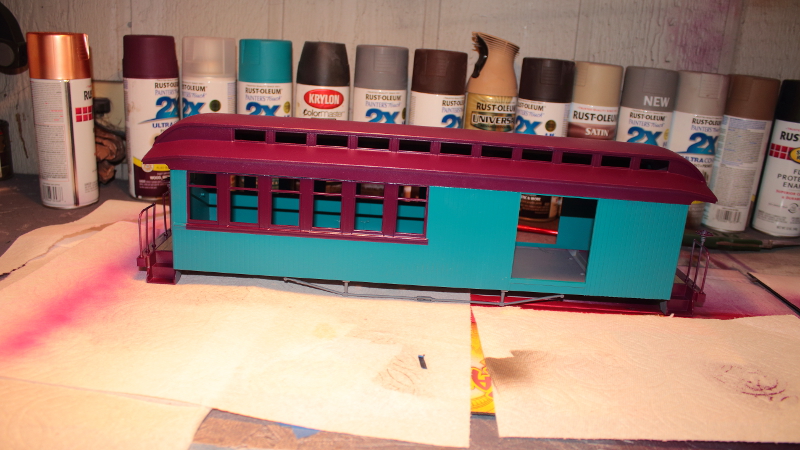
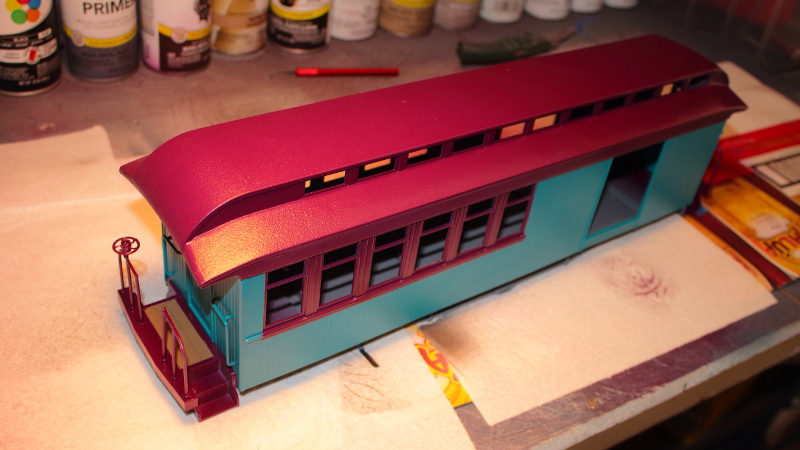
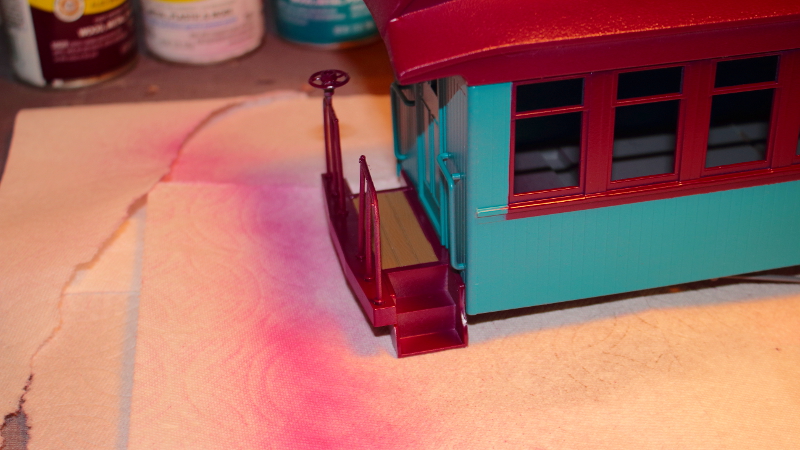
I use a mixture of dilute acrylic paints and powders. Here’s my business coach.

Like Pete mentioned, I use a very dilute mixture of acrylic paints and water. Mine are probably less than 50%, but I usually just have the paint in one thing, water in another, and mix the two on a third with the brush. If it’s too heavy on the model, I add more water. If it’s too light, I add more paint.
Here’s a photo of the wash being applied to a locomotive:

On a passenger car–especially one that is more-or-less well taken care of, I apply the wash, and then go through with a lint-free cloth to wipe off the excess. I want to retain the glossy sheen of the base paint, and if I just leave the wash on, the surface becomes matte. Here’s a side shot of the passenger car, where you can see where the wash has been wiped off.

The ends and trucks are brushed with weathering powders. If the ends are plastic, I’ll dry-brush grey/tan paint to simulate worn paint on the steps. If they’re wood, I’ll take some sandpaper and sand through the paint to the wood.


Note, I do not use any kind of spray fixative on the powders. I can’t spray that and maintain the different sheens of the various surfaces. The powders are easy to re-apply should they wear off through handling, etc.
Later,
K
Nice!
That is a fine looking coach Pete. is it custom?
It’s a regular Accucraft Jackson & Sharp with a few mods. Extra windows - there’s one more each side for the bathroom, and 2 each end next to the doors… The clerestory has a laser-cut overlay (I think) and the top of the windows and letter board is a piece of styrene.
Just to elaborate on the “wash” technique - I find the acrylics (lampblack from Michaels Crafts is one of my favorites) stay firmly on the coach and need no overspray. Dullcote is not UV protected, by the way, so if you use that, don’t leave the coach out in the sun for long. Kevin and I modeled a coal carrier, so our dirty rolling stock has a good element of black in it. But the same works for browns or even lighter colors.
After washing a lot of the dilute paint, I dab the bottom of the sides with paper towel to absorb the run-off. It dries in the grooves and corners - as you can see on Kevin’s coach - so it looks very prototypical. I do not cover the windows - it the coach is dirty, gthen so are the windows! I usually wipe them down before the paint dries with more paper towel to give the a prototypical ‘just rubbed’ look.
This is one of the first coaches i ‘washed’, an old Bachmann combine.
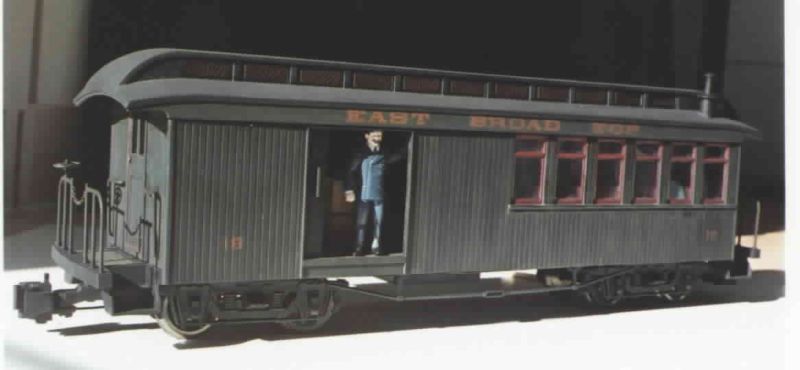
Almost the final color scheme. Detailing is probably 90% of what I want. Of course, I still have to do the other side, and the other end. And the under carriage. And weathering…

(https://largescalecentral.com/externals/tinymce/plugins/emoticons/img/smiley-laughing.gif)Yep, those, and … and … and … and’s are the tale of many a project.
To me, what would look good in the clerestory windows is that color swirl glass which had for example swirls of red, yellow, blue, in mostly white.
Right now my cars with it are not at home, can’t find a picture in my files, and in one of its rare uncooperative moments Google isn’t finding any either.
Do know a couple interurban lines used such glass even in upper panes of side windows, especially the arched ones.
Note that this is different from (and cheaper than) the leaded glass occasionally used.
But how I make it is …
Lightly sand one side of clear styrene sheet.
On that side, swirl on small areas of fingertip to pencil eraser size, of moderately thinned color paint: use a small round brush.
When that dries airbrush over it with thinned white.
Attach from inside clerestory with shiny side out and there ya go!
One trick I have used to get graying of paint is to coat the car with a dull clear coat. Once it has dried for a few days, I mist the car with isopropyl alcohol, the alcohol causes the dull coat to fog a bit. It gives the effect of the paint chalking.
Of course another thing to consider is what kind of passenger service are we talking about. If its the pride of the railroad, the cars are well maintained. If its a “we keep the the passenger train because we have to.” Then the cars will be grungier and less cared for. If its a bankrupt line, running the train solely because of a mail contract, then it could be rather rickety. And even the class one passenger trains were looking rather poorly, just before they gave up passenger service and turned their passenger equipment over to Amtrak.
If you want to talk about “and… and… and,” the photos of my business car were taken 10 years ago. I found them on an old MyLargeScale post. In that post, I mention that it took me 2 years to get to that point, and that if I was good, I’d finish it by the time my daughter was in Kindergarten. She’s in 6th grade now. The interior of that car is still not finished.
It’s the journey, not the destination, right?
Later,
K
To me, what would look good in the clerestory windows is that color swirl glass which had for example swirls of red, yellow, blue, in mostly white.
On a coach I did the clerestory with stained glass. Found a design on the 'net, and printed some clear Avery labels on the inkjet. Then I stuck them on clear acrylic.
Pete Thornton said:
On a coach I did the clerestory with stained glass. Found a design on the 'net, and printed some clear Avery labels on the inkjet. Then I stuck them on clear acrylic.
Hey, that’s an idea!
Did you use a brush on that car Daniel? if so you have a steady hand. If you sprayed it then you have patience in masking.
I think with those bright colours that those cars would be the pride of the RR which means they would be kept clean. If they were mine I would lightly weather the trucks and undercarriage and remove any shine from the paint and stop there.
Did you use a brush on that car Daniel? if so you have a steady hand. If you sprayed it then you have patience in masking.
I think with those bright colours that those cars would be the pride of the RR which means they would be kept clean. If they were mine I would lightly weather the trucks and undercarriage and remove any shine from the paint and stop there.
Mostly sprayed. Some hand brushing.
Make sure you weather the finished car … unless you are trying to recreate a rehabbed coach…
A rehab coach? I thought this was a model train website.